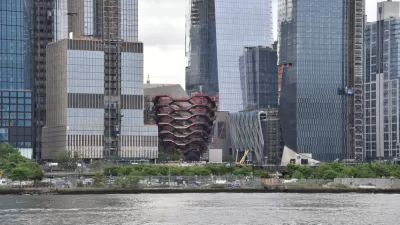In this New York Times opinion, health issues correspondent Meera Senthilingam writes that too much of New York City is not designed for physical activity, including walking. Imagine what the suburbs and less vibrant cities are like!
"Despite a firm reputation for being walkers, New Yorkers have an obesity epidemic on their hands," writes Meera Senthilingam, a British freelance journalist who covers global health issues. "Lee Altman, a former employee of New York City’s Department of Design and Construction, explains it this way: “We did a very good job at designing physical activity out of our daily lives."
According to the city’s health department, more than half of the city’s adult population is either overweight (34 percent) or obese (22 percent), and the convenience of their environment has contributed to this. “Everything is dependent on a car, elevator; you sit in front of a computer,” said Altman, “not moving around a lot.”
Developers and planners need to design buildings and streetscapes to encourage more physical activity and less on 'convenience.' In doing so, they will be joining "a global movement known as 'active design' to get urbanites onto their streets and enjoying their surroundings on foot, bike or public transport."
“The communities that have the least access to well-maintained sidewalks and parks have the highest risk of obesity and chronic disease,” said Joanna Frank, executive director of the nonprofit Center for Active Design. Even adding items as straightforward as benches and lighting to a streetscape can greatly increase the likelihood of someone’s choosing to walk, she said.
Former New York City Mayor Mike Bloomberg issued an executive order three years ago "requiring all new government facilities to be designed in a way that encourages physical activity, like taking the stairs," notes a 2013 post on active design.
Frank lists four areas that need the attention of planners and designers if we are to use the built environment to tackle obesity: transportation, recreation, buildings and access to food.
In order to get people outside more the city's pedestrian Plaza Program was motivated by "studies showing that people needed to live within 10 minutes of a park, or open space, in order to use it."
Among the New York City pedestrian projects cited by Senthilingam is a "25-block pedestrian walkway that stretches south from Times Square toward Union Square along Broadway, complete with room for stands where local vendors do business with the passers-by." Download [PDF] a slideshow (presented in October 2012): Broadway Blvd. — W. 42nd to 35th Streets.
Paradoxically, active design can conflict with other goals, like moving people quickly and efficiently on some of New York's more crowded sidewalks. Letter-writers on July 11 expressed their displeasure with vendors for taking-up valuable walking space.
FULL STORY: Designing an Active, Healthier City

Planetizen Federal Action Tracker
A weekly monitor of how Trump’s orders and actions are impacting planners and planning in America.

Maui's Vacation Rental Debate Turns Ugly
Verbal attacks, misinformation campaigns and fistfights plague a high-stakes debate to convert thousands of vacation rentals into long-term housing.

San Francisco Suspends Traffic Calming Amidst Record Deaths
Citing “a challenging fiscal landscape,” the city will cease the program on the heels of 42 traffic deaths, including 24 pedestrians.

Defunct Pittsburgh Power Plant to Become Residential Tower
A decommissioned steam heat plant will be redeveloped into almost 100 affordable housing units.

Trump Prompts Restructuring of Transportation Research Board in “Unprecedented Overreach”
The TRB has eliminated more than half of its committees including those focused on climate, equity, and cities.

Amtrak Rolls Out New Orleans to Alabama “Mardi Gras” Train
The new service will operate morning and evening departures between Mobile and New Orleans.
Urban Design for Planners 1: Software Tools
This six-course series explores essential urban design concepts using open source software and equips planners with the tools they need to participate fully in the urban design process.
Planning for Universal Design
Learn the tools for implementing Universal Design in planning regulations.
Heyer Gruel & Associates PA
JM Goldson LLC
Custer County Colorado
City of Camden Redevelopment Agency
City of Astoria
Transportation Research & Education Center (TREC) at Portland State University
Jefferson Parish Government
Camden Redevelopment Agency
City of Claremont




























